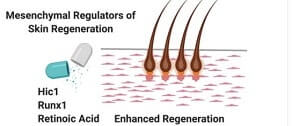Skin Regeneration, Wound Healing and Hair Growth
Two recent papers published important new findings in regards to wound healing and skin regeneration.
Wound healing via skin regeneration is often accompanied by hair follicle regeneration. Or even by brand new hair follicle neogenesis (e.g., Follica).
On a related note, thousands of hair loss sufferers around the world are trying out at-home microneedling and dermarolling. Many of them have seen significant success, although one has to be careful with this type of scalp self-injury. On our hair loss chat, the most interesting recent discussion is around wounding depth levels.
Human embryonic and neonatal skin has the potential to regenerate after wounding. This includes fully functioning hair follicles. However, adult skin no longer has such regenerative capabilities. Researchers have been trying for years to find ways to coax salamander-like regenerative powers in humans. If not for whole limbs, at least for hair growing skin to cover baldness for our sake.
New Studies on Skin Regeneration and Wound Healing
- In September 2020, a team that included Dr. Jeff Biernaskie published a study on the regenerative potential of dermal fibroblasts during wound healing. They identified a specific population of progenitor cells that reside within the dermis and which aid in wound healing.

The research is shared on GitHub. Also see Biernaskie Lab. According to the findings, Runx1, retinoic acid, and Hic1 control mesenchymal regenerative capabilities.
According to this summary, Dr. Biernaskie (whose work I have covered in the past) said that they have shown the following:
“You can alter the wound environment with drugs, or modify the genetics of these progenitor cells directly. Both are sufficient to change their behavior during wound healing. And that can have really quite impressive effects on healing that includes regeneration of new hair follicles, glands and fat within the wounded skin.”
“It suggests that the adult wound-responsive cells do in fact harbor a latent regenerative capacity, it just simply needs to be unmasked.”
- Also in September 2020, a new study from the University of Washington identified Wnt transcription factor Lymphoid enhancer-binding factor 1 (LEF1) as the key factor in adult skin regeneration.
LEF1 gene expression in fibroblasts has the potential in adult skin to repair itself like the skin of a newborn baby. This skin can also grow new hair follicles.
Interview with lead author Dr. Ryan Driskell.
“We identified a genetic factor that allows adult skin to repair itself like the skin of a newborn baby.”
Hair, Skin and Wounding Interconnected Research
While writing this post, I could not believe the number of diverse past posts on this blog that have focused on skin regeneration, wound healing and hair formation.
-
- I have covered PolarityTE a number of times. The company claims that its technology can grow new skin with fully intact sweat glands and hair follicles. Also see my past posts on companies involved in 3D bioprinting of hair and skin.
- Earlier this year, I wrote about hair-bearing human skin that was generated entirely from pluripotent stem cells.

- Another item of interest entails activation of the Sonic Hedgehog Pathway and subsequent wound healing and hair regrowth.
- Also see the connection between wounding, interleukin-1 and hair growth.
- For a fascinating and yet comedic take, I recommend reading “never too old to regenerate hair“.
- Follica and wounding. And of course the popular related subjects of microneedling and dermarolling that I have written about a number of times.
- Also see my posts on the Uniformed Services University and its work to create cell-based skin substitutes for the US military. I have also mentioned Wake Forest and its skin cell printing project in the past.
- Several fibroblast growth factors promote hair follicle growth after wounding. See the FGF section in my post on growth factors in PRP. And this FGF-9 patent from U Penn.
Renowned hair loss researchers such as Dr. George Cotsarelis, Dr. Luis Garza, Dr. Ealine Fuchs and Dr. Mayumi Ito have all also conducted frequent research on skin regeneration. I have discussed their work in past posts if you search for their names.
My gut feeling is that whenever there is a fully effective cure for hair loss, there is a strong likelihood that there will also be a cure for quality skin regeneration.
Skinregeneration.org
The authors of the second study that I linked to earlier have started a new site called skinregeneration.org. The site’s mission is to provide a platform for scientists to easily query large datasets that focus on skin wounding and scarring repair.
For further information, see the Driskell Laboratory site at Washington State University.
Skin Gun and Spray-On Skin
It seems like the technology to repair skin has improved significantly during the past decade. There is an especially unmet need when it comes to treating skin that has been burnt badly.
One of the technologies that I used to very curious about is the skin gun. I have not heard much about this in recent years. RenovaCare acquired the technology in 2013. The company’s skin gun and spray-on stem cells for wound healing are trademarked under the names SkinGun and CellMist
and CellMist .
.
The post Skin Regeneration, Wound Healing and Hair Growth appeared first on Hair Loss Cure 2020.
